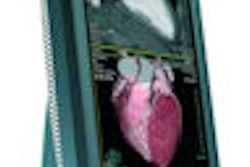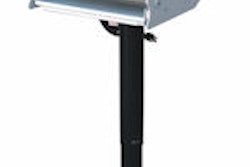BOSTON - As radiologist workloads increase, researchers are examining new methods for improving productivity and lowering the risk of repetitive stress injury (RSI). In separate presentations Monday at the American Roentgen Ray Society (ARRS) meeting, researchers found that using a Nintendo Wii remote could reduce the risk of RSI, while listening to Baroque classical music showed promise for improving efficiency.
The traditional keyboard and mouse-based interface used with PACS has led to a growing concern over RSIs, and it also constrains the ways in which radiologists can interact with large image datasets. In a quest for an alternative input device, researchers from the New York-Presbyterian Hospital in New York City and the National University of Singapore evaluated the use of a Wii remote controller (Wiimote) from the Nintendo Wii gaming system for manipulating imaging studies.
The study team utilized the Wiimote's motion-sensing capability to allow radiologists to scroll, pan, window, and zoom through an image set via hand movements and pointing, according to presenter Dr. Cliff Yeh. A dedicated Wiimote DICOM image viewing application was developed in collaboration with the National University of Singapore.
To compare the accuracy of the Wiimote approach with a regular PACS viewer, the researchers evaluated the use of the controller by three attending radiologists with two to six years of subspecialty experience. They each reviewed 20 CT studies that they had read from at least one year earlier.
The studies were first de-identified and loaded onto a laptop, then read using the Wiimote viewer. The researchers compared the findings from the original report and the Wiimote report.
They found a statistically significant correlation for all three radiologists between the Wiimote findings and the PACS findings, and also for both critical and incidental findings, Yeh said.
"Our limited evaluation shows good interpretation accuracy," he said.
The study team also queried the radiologists for their opinions on the Wiimote system. All three agreed that it was easy to use and learn, and it can be as accurate as a conventional keyboard-mouse reporting environment. In addition, all agreed that the keyboard-mouse approach can be improved upon, they would occasionally use the Wiimote system if it were integrated with a PACS, the system was an ergonomic way to interpret studies, and it may reduce RSI, Yeh said.
"Alternative input devices should be developed to help radiologists and reduce RSI," he said. "While the current Wiimote may not serve as the tool in the end, we believe it's a good proxy for an ergonomically favorable alternative input device."
The researchers also believe the Wiimote could help encourage ergonomically correct work postures, although further studies need to be performed to confirm that hypothesis, according to Yeh.
Baroque music
In another presentation, a research team led by Dr. Sohaib Mohjuddin of the University of Maryland in Baltimore found that Baroque classical chamber music improved radiologist productivity and work satisfaction.
With the increased workload of today's radiologists, the study group sought to examine how environmental factors could improve the work environment for today's busy radiology reading rooms. Eight radiologists (four men and four women) from the University of Maryland in Baltimore and the University of Pennsylvania Health System in Philadelphia were recruited for the study. The group included four residents, three attending physicians, and one fellow.
All participants were asked to listen to one hour of classical chamber music from the Baroque period while interpreting radiological studies during a typical day. The music was played from a PC workstation at an ambient volume from the Pandora online music service.
Afterward, the radiologists took an anonymous online survey, rating their mood, concentration, perceived diagnostic accuracy, productivity, and work satisfaction on a seven-point Likert scale.
Of the eight, four indicated they had listened to five hours of music per week. Five said they had listened to classical music, while three didn't. Five also indicated they rarely or never listened to music during the workday. Two said they sometimes listened to music, while one said they frequently did.
Five (62.5%) said that listening to music made them more relaxed, indicating an overall positive effect with regard to mood, Mohjuddin said. Three (37.5%) noted a positive effect with regard to concentration, while two (25%) reported a positive effect on productivity. Two (25%) indicated a positive effect on diagnostic accuracy, while four (50%) said they felt an overall improved work satisfaction.
Only one (12.5%) participant reported a negative impact from listening to music, reporting a negative effect on concentration.
In other results, women (6.0 ± 0.8) indicated a significantly greater positive effect on mood than men (4.3 ± 0.6; p < 0.03). Also, there was a significantly greater positive effect on mood for those who play or have previously played musical instruments (6.3 ± 0.6 and 4.4 ± 0.5, respectively; p < 0.03). Participants who listened to more than five hours of music per week also had higher positive mood scores (5.0 ± 0.8) than those who did not (3.8 ± 0.5; p < 0.06).
"Classical music from the Baroque period appears to confer the greatest benefit in terms of mood and work satisfaction," Mohjuddin said.
By Erik L. Ridley
AuntMinnie.com staff writer
April 28, 2009
Related Reading
PACS software tool boosts clinical follow-up, December 15, 2008
QA tool cuts errors in radiation oncology department, August 6, 2008
Mayo pares PACS limitations with intelligent image routing, June 11, 2008
Software unifies control of multiple informatics applications, June 2, 2008
Communication and prevention are key to minimizing PACS downtime effects, May 19, 2008
Copyright © 2009 AuntMinnie.com



















